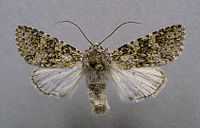Polymixis xanthomista
| Polymixis xanthomista | |
|---|---|
 | |
| Scientific classification | |
| Kingdom: | Animalia |
| Phylum: | Arthropoda |
| Class: | Insecta |
| Order: | Lepidoptera |
| Family: | Noctuidae |
| Genus: | Polymixis |
| Species: | P. xanthomista |
| Binomial name | |
| Polymixis xanthomista (Hübner, 1819) | |
| Synonyms | |
| |
The Black-banded Polymixis (Polymixis xanthomista) is a moth of the Noctuidae family. It is found in West Europe, South Europe and East to Romania, Hungary and Slovenia and also in North Africa.In the Alps it rises to 2000 meters asl.
Technical Description and variation
- See glossary for terms used
Forewing greyish white, thickly dusted with blackish grey, the median area filled up with blackish ; the edges of the lines and stigmata and the course of vein 1 picked out with yellow scales; the upper stigmata large and paler, the orbicular with a dark dot in middle; submarginal line preceded by wedgeshaped black marks; hindwing of male white, with the veins blackish and sometimes a slight grey submarginal band before the blackish marginal line; of female uniform dark grey; — nigrocincta Tr. , the more common form, is blacker, with the yellow scales more or less obsolete;- nivescens Stgr. from the chalk district of the Jura, Switzerland, has the ground colour of the basal and marginal areas much whiter; — statices Gregs. is a dark smaller race from the Isle of Man; its main difference is that the inner and outer lines edging the blackish median area are more distinctly and broadly white, especially below the middle; the amount of yellow scaling is variable.[1]
Biology
Adults are on wing from the end of August to mid October. Larva reddish-brown, thickly speckled with dark atoms, which form a dorsal and two broader subdorsal The larvae feed on various plants, including Plantago, Taraxacum, Verbascum, Rumex, Lonicera and Prunus padus.[2] Subspecies statices has been recorded on various low growing plants, including Armeria maritima and seems to prefer the flowers.
Subspecies
- Polymixis xanthomista xanthomista (North Africa through western Southern Europe, east to Romania, Hungary and Slovenia)
- Polymixis xanthomista statices Gregson, 1869 (Great Britain)
- Polymixis xanthomista lutea Schwingenschuss, 1963 (Morocco)
- Polymixis xanthomista hadenina Rungs, 1972 (Morocco)
- Polymixis xanthomista rmadia Rungs, 1967 (Morocco)
- Polymixis xanthomista meftouha Rungs, 1967 (Morocco)
- Polymixis xanthomista chehebia Rungs, 1972 (Morocco)
References
- ↑ Seitz, A. Ed., 1914 Die Großschmetterlinge der Erde, Verlag Alfred Kernen, Stuttgart Band 3: Abt. 1, Die Großschmetterlinge des palaearktischen Faunengebietes, Die palaearktischen eulenartigen Nachtfalter, 1914
- ↑ "Robinson, G. S., P. R. Ackery, I. J. Kitching, G. W. Beccaloni & L. M. Hernández, 2010. HOSTS - A Database of the World's Lepidopteran Hostplants. Natural History Museum, London.".
External links
| Wikimedia Commons has media related to Polymixis xanthomista. |